TrendVision MR-710GP: the best mirror DVR 2015
Perhaps the main and most obvious advantage of DVRs in the body of the mirror is the possibility of hidden installation. And if earlier the choice of motorists was limited to registrars in such a form factor far from the most modern technical characteristics, now this misunderstanding has been fixed.
A few days ago, TrendVision presented a mirror DVR built on the basis of the most powerful video processor used in recorders - Ambarella A7LA70 in conjunction with the best sensor of 2014 - OmniVision OV4689 (CMOS 1/3 ", 4MP). The advantage of the new TrendVision MR video recorder -710GP over closest competitors will be installed in the device superlight 8-lens (F = 1.6) .

The bundle used in TrendVision MR-710GP is capable of recording video with a super high resolution of 2304x1296 (3K), which is 1.4 times more than most recorders with a resolution of 1920x1080 (2.1K). In addition, there is a 60-fps high-speed shooting mode with a resolution of 1920x1080.
')
The main feature of this element base is the HDR mode (high dynamic range), implemented by the hardware of the OmniVision OV4689 sensor without the use of processor power.
Hardware HDR allows you to get a wider dynamic range in the resolution of 1920x1080 than with software WDR. At the same time, unlike the widely advertised software modes WDR, the hardware HDR (high dynamic range) of the MR-710GP allows you to create a really high-quality picture in a high-contrast scene and low light conditions. For example, state license plates in front of a car going at night are likely to be read, rather than a white blur.
WDR mode implemented by the processor software in the MR-710GP is also implemented!
TrendVision MR-710GP is a pad on the standard rear-view mirror. Installation of the DVR is possible on a regular mirror of any thickness and is carried out with the help of two rubber holders having an adjustable length.
The appearance of the rubber holders is presented in the photo below. There are 4 of them in total. Spare two pieces are needed in case the main pair is damaged.

I personally tried to install this DVR on thin regular mirrors of Renault Sandero and VW Polo cars, a relatively thick mirror - LADA Priora and on a mirror of not the most standard form - Nissan Primera.
As for the DVR case, I note that the case is completely original, has no analogues among competitors and, according to the manufacturer, the design took into account all the comments and wishes of users to the previous TrendVision TV-103 model. So if any manufacturer named **** cam has a registrar in the exact same case, then we can safely say that the idea was taken from TrendVision.
The main features of the advanced case are:
• anti-glare mirror surface
• ultra-thin body, thickness only 14mm
• power connectors, remote camera, HDMI and AV are recessed into the case
• 4.3 ”monitor, huge by DVR standards
• removable polarizing filter
• hidden buttons
• automatically turn off button illumination
• two slots for microSD and SD memory cards located below
Some features I will comment on.
1) So, unlike the overwhelming majority of DVRs in the mirror form factor, having only one memory card slot, the new TrendVision MR-710GP has got two slots for SD and microSD memory cards . An important feature is the location of these slots on the bottom of the case, when other devices slot is located in the upper part of the case, which greatly complicates the removal of the memory card.

2) TrendVision MR-710GP is one of the few DVRs in general and the only DVR in the form of a mirror (except for competitive models from TrendVision itself), which has a removable polarization filter that allows you to reduce parasitic reflections from the windshield on a sunny day. In simple terms - CPL-filter eliminates the reflection of a torpedo or any objects located on the panel and reflected in the windshield.
Video example of the operation of the CPL filter:
Some profile forums came up with examples where people themselves "collective farm" filters on DVRs and mirrors. In the case of the new MR-710GP, nothing “collective farm” is needed, everything is already provided for by the manufacturer.
As for the installation of the polarization filter, this action is visually presented below: a threaded adapter is mounted on the lens ring, on which the CPL filter itself “sits down”. The installation, of course, is not as fast as, for example, for TrendVision TV-Q5NV or TV-107 models, which are equipped with a CPL filter on a magnet.
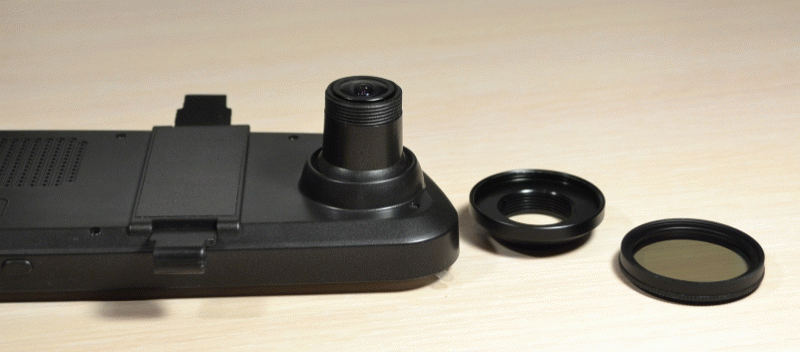
3) TrendVision MR-710GP, unlike everything from the same old model TrendVision TV-103 and a number of other mirror DVRs, got a huge monitor by the standards of similar devices - 4.3 inches . Below is a photo for visual comparison of the monitor MR-710 with the monitor of another mirror-DVR (4.3 inches vs. 2.7 inches).
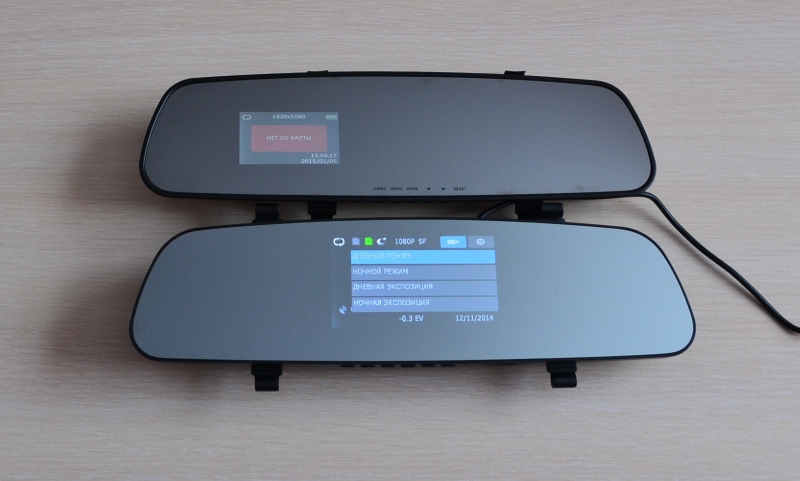
4) Device control buttons are located on the bottom of the DVR case. The buttons are convex. To grope the button you need while driving, for example, a button to manually protect the video from being overwritten - no problem. Verified! And during the movement itself, you may need only one button to protect the video from being overwritten (the first on the left) or a button to mute the microphone (the second on the left).
The names (main purpose) of the buttons are duplicated on the mirror itself. When the screen is on, the buttons (titles) are highlighted . The backlight of the buttons turns off automatically 20 seconds after switching on.
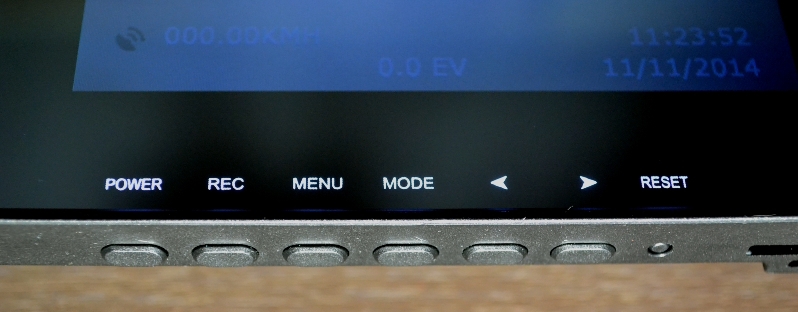
5) Power connectors, remote camera, HDMI and AV are recessed in the case. For my car, this moment is not so important, as the standard rear-view mirror is not too close to the ceiling - respectively, the plugs do not rest on anything. But for some cars, this (in-depth) location of the connectors is necessary!
For example, I took a couple of extracts from reviews from Yandex.Market about video recorders-mirrors, in which the connectors are located at the top of the case and are not deepened:

6) As for the anti-glare coating of the mirror surface , then I can only say one thing: a standard mirror is installed on my car and I am not spoiled by the auto-dimming function. So, to say for sure how anti-glare coating on MR-710GP is really anti-glare - I can not. The only thing I will note is that the mirror surface of the DVR itself is somewhat darkened, so the discomfort from the back of the driving car in the dark is really less.
Another feature of TrendVision MR-710GP is the ability to connect an analog parking camera. When power is supplied to the parking camera, the monitor of the DVR is turned on automatically (if it was turned off at that time) and the image from the camera is displayed on it. Video recording from the parking camera is not performed.
For people who have not previously encountered DVRs in the body of the mirror, I note that the camera is connected to the body with a hinge. Accordingly, the camera rotates absolutely in any direction at a certain angle, which will be sufficient for accurate positioning of the camera exactly on the road.
If several people use the car, and the new driver decides to reconfigure the mirror for himself, then in just a few seconds it will be possible to reconfigure the camera itself. In this regard, no inconvenience will arise.
• DVR mirror TrendVision MR-710GP
• Car cigarette lighter charger
• AV cable to connect the monitor
• MicroUSB-USB cable for PC connection
• MiniUSB-AV cable for connecting an analog parking camera
• Rubber holders for mounting (4 pcs.)
• Polarizing CPL filter
• GPS receiver and 3M scotch for it
• Cloth for wiping optics and mirror surface
• Instruction, warranty card
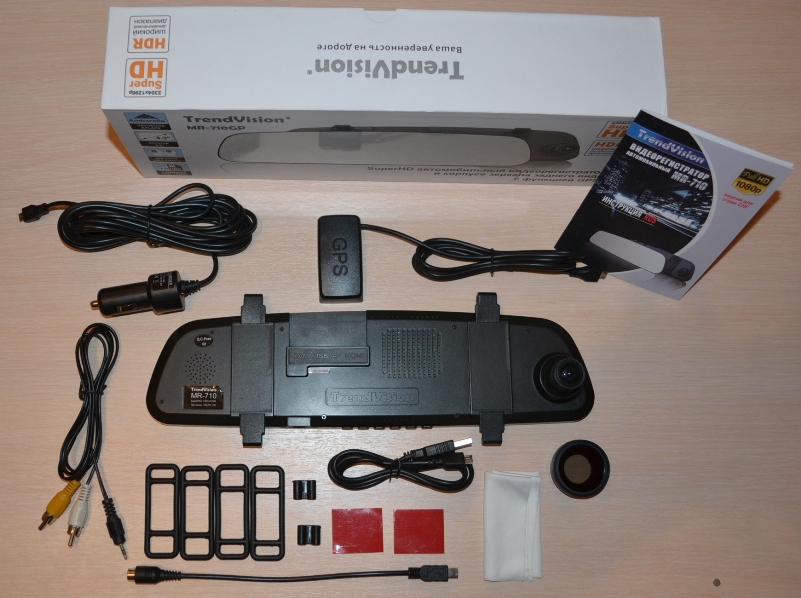
TrendVision MR-710GP has advanced software. In addition to the mandatory functions for the DVR, such as automatic power on and off, loop recording, the shock sensor, the MR-710GP has many additional features. Through the settings it is possible to set separate settings and modes for day and night time of day. In particular, for daytime, for example, you can install SuperHD 2304x1296, and for nighttime - HDR1080.
By the way, I consider the settings for daylight and darkness, indicated by me above, to be the most optimal, although nobody forbids experimenting and having an opinion different from mine.
A slight digression about SuperHD ...
Despite the fact that in many advertising publications SuperHD permission is often overestimated, there is still a practical sense of it, in particular, when, for example, it is necessary to recognize the license plate number of the person responsible for the accident, who left after the "contact" of cars.
The difference in quality between SuperHD and FullHD is somewhere around 40% across the frame: vertically and horizontally. This means that the dimensions of the object, when viewed separately vertically and horizontally, increase by 20%. That is, the distance reading numbers increases all the same by 20%. And if before the car number was read, say, from 10 meters, then with SuperHD it will be read from 12 meters.
The exposure level can also be set separately for day and night time of day. Contrary to popular belief, at night it is better to shift the exposure to minus, for example -0.7. This allows you to reduce the illumination of the headlights and reduce the blurring of fast-moving objects. The brightness can always be increased in any video player.
Exposure, resolution and recording mode will be changed automatically at a specified time. Time can be set independently any.
Now for the memory cards. As I noted above, TrendVision MR-710 has two slots for memory cards. Video recording will be made only on one card, the second memory card can only serve as a backup card (you can also enable video recording on it, but only manually) or to create a “copy for the protocol” (copy of a video clip from one card to the second).
Why is there no loop recording at the beginning on one memory card, then on the other and so on? No, because it is not required. The MR-710GP supports the exFat file system, that is, you can install memory cards of 128 or 256 GB in the recorder - and this will be quite enough.
Digital zoom.
When playing video on the monitor of the DVR, you can use the digital zoom function to view some small details, such as the vehicle number. This feature provides for a 10-fold increase in any part of the frame.
LDWS and FCWS mode.
Again, in many advertising reviews of a particular DVR model, the authors often focus on two modes: LDWS and FCWS. In TrendVision MR-710, these two modes are also implemented.
How these modes will be useful in real conditions, I can only guess. Making constant trips mostly only around the city, I personally do not use these modes. But making a long trip on the highway, these functions can really come in handy, especially if there is a tendency to fall asleep at the wheel.
Warning about changing lanes or a possible collision is carried out by the voice of a person. All voice prompts accompanying the operation of the DVR are also carried out in a human voice.
Below, under the spoiler is a brief information about TrendVision MR-710GP. Some technical features and software features in this section are described in more detail.
Please note that YouTube video hosting significantly impairs video quality.
To assess the real quality of the video - download the original files!
SuperHD
Download original
SuperHD
Download original
HDR1080
Download original
HDR1080, night
Download original
HDR1080, night
Definitely TrendVision MR-710GP is by far the best DVR in the mirror housing. With great confidence I can say that this model will retain its position throughout the whole of 2015.
If we compare this DVR-mirror with any other DVR in a different form factor, then without a doubt we can say that TrendVision MR-710GP is one of the leading lines among all DVRs in terms of technical characteristics, video quality, features and functionality. it is difficult to name the model that he would concede today.
A few days ago, TrendVision presented a mirror DVR built on the basis of the most powerful video processor used in recorders - Ambarella A7LA70 in conjunction with the best sensor of 2014 - OmniVision OV4689 (CMOS 1/3 ", 4MP). The advantage of the new TrendVision MR video recorder -710GP over closest competitors will be installed in the device superlight 8-lens (F = 1.6) .

The bundle used in TrendVision MR-710GP is capable of recording video with a super high resolution of 2304x1296 (3K), which is 1.4 times more than most recorders with a resolution of 1920x1080 (2.1K). In addition, there is a 60-fps high-speed shooting mode with a resolution of 1920x1080.
')
The main feature of this element base is the HDR mode (high dynamic range), implemented by the hardware of the OmniVision OV4689 sensor without the use of processor power.
Hardware HDR allows you to get a wider dynamic range in the resolution of 1920x1080 than with software WDR. At the same time, unlike the widely advertised software modes WDR, the hardware HDR (high dynamic range) of the MR-710GP allows you to create a really high-quality picture in a high-contrast scene and low light conditions. For example, state license plates in front of a car going at night are likely to be read, rather than a white blur.
WDR mode implemented by the processor software in the MR-710GP is also implemented!
Specifications TrendVision MR-710GP
| Element base | CPU | Ambarella A7LA70 |
| Matrix | OmniVision OV4689, CMOS 1/3 ', 4Mp | |
| Optics | glass lens, 8 lenses, F = 1.6, f = 2.9mm | |
| RAM | 2GB DDR3 | |
| Video | Viewing angle | 147 ° diagonal, 107 ° horizontal |
| Resolution | 2304x1296p 30 fps 2560x1080p 30k / s 1920x1080p 60k / s, 45k / s, 30 fps 1280x720p 60k / s, 45k / s, 30 fps | |
| Day / night mode | Separate settings for resolution and exposure for day and night time. The mode change is automatic. | |
| Loop Recording | Loop recording in 1/2/3/5 min. Automatic sequential rewriting of old blocks when filling a memory card. | |
| Enable Record | when supplying external power | |
| Recording off | when removing the external power, the off delay is configured in the menu | |
| Compression / Format | H.264 (Mpeg-4, part.10) / .MP4 | |
| Audio | Speaker | built-in, volume control |
| Microphone | built-in, the ability to turn off the button or through the menu | |
| A photo | Quality | 1920x1080 resolution |
| View | Monitor | 4.3 ", high contrast, view recordings in place, automatically turning off the screen after a specified time |
| Video output | - AV port - HDMI port | |
| Reproduction | yes, freeze frame, fast forward / backward, slow motion forward / backward | |
| ZOOM | digital when playing video | |
| Memory | Memory card | microSD XC, exFat 128GB support SD XC support exFat 128GB |
| Overwrite protection | there is a button or using the G-sensor | |
| Backup | the ability to copy any video or several videos from one memory card to another memory card without restrictions | |
| Nutrition | Battery | built-in, 300mA / h, about 20 minutes of battery life |
| Power input | Micro USB, included adapter in the cigarette lighter | |
| Other | ||
| Menu language | Russian English | |
| Dimensions | 14x83x314 (W × H × D) | |
| Temperature conditions | from -25 ° to + 40 ° |
Appearance and convenience
TrendVision MR-710GP is a pad on the standard rear-view mirror. Installation of the DVR is possible on a regular mirror of any thickness and is carried out with the help of two rubber holders having an adjustable length.
The appearance of the rubber holders is presented in the photo below. There are 4 of them in total. Spare two pieces are needed in case the main pair is damaged.
I personally tried to install this DVR on thin regular mirrors of Renault Sandero and VW Polo cars, a relatively thick mirror - LADA Priora and on a mirror of not the most standard form - Nissan Primera.
As for the DVR case, I note that the case is completely original, has no analogues among competitors and, according to the manufacturer, the design took into account all the comments and wishes of users to the previous TrendVision TV-103 model. So if any manufacturer named **** cam has a registrar in the exact same case, then we can safely say that the idea was taken from TrendVision.
The main features of the advanced case are:
• anti-glare mirror surface
• ultra-thin body, thickness only 14mm
• power connectors, remote camera, HDMI and AV are recessed into the case
• 4.3 ”monitor, huge by DVR standards
• removable polarizing filter
• hidden buttons
• automatically turn off button illumination
• two slots for microSD and SD memory cards located below
Some features I will comment on.
1) So, unlike the overwhelming majority of DVRs in the mirror form factor, having only one memory card slot, the new TrendVision MR-710GP has got two slots for SD and microSD memory cards . An important feature is the location of these slots on the bottom of the case, when other devices slot is located in the upper part of the case, which greatly complicates the removal of the memory card.
2) TrendVision MR-710GP is one of the few DVRs in general and the only DVR in the form of a mirror (except for competitive models from TrendVision itself), which has a removable polarization filter that allows you to reduce parasitic reflections from the windshield on a sunny day. In simple terms - CPL-filter eliminates the reflection of a torpedo or any objects located on the panel and reflected in the windshield.
Video example of the operation of the CPL filter:
Some profile forums came up with examples where people themselves "collective farm" filters on DVRs and mirrors. In the case of the new MR-710GP, nothing “collective farm” is needed, everything is already provided for by the manufacturer.
As for the installation of the polarization filter, this action is visually presented below: a threaded adapter is mounted on the lens ring, on which the CPL filter itself “sits down”. The installation, of course, is not as fast as, for example, for TrendVision TV-Q5NV or TV-107 models, which are equipped with a CPL filter on a magnet.

3) TrendVision MR-710GP, unlike everything from the same old model TrendVision TV-103 and a number of other mirror DVRs, got a huge monitor by the standards of similar devices - 4.3 inches . Below is a photo for visual comparison of the monitor MR-710 with the monitor of another mirror-DVR (4.3 inches vs. 2.7 inches).
4) Device control buttons are located on the bottom of the DVR case. The buttons are convex. To grope the button you need while driving, for example, a button to manually protect the video from being overwritten - no problem. Verified! And during the movement itself, you may need only one button to protect the video from being overwritten (the first on the left) or a button to mute the microphone (the second on the left).
The names (main purpose) of the buttons are duplicated on the mirror itself. When the screen is on, the buttons (titles) are highlighted . The backlight of the buttons turns off automatically 20 seconds after switching on.
5) Power connectors, remote camera, HDMI and AV are recessed in the case. For my car, this moment is not so important, as the standard rear-view mirror is not too close to the ceiling - respectively, the plugs do not rest on anything. But for some cars, this (in-depth) location of the connectors is necessary!
For example, I took a couple of extracts from reviews from Yandex.Market about video recorders-mirrors, in which the connectors are located at the top of the case and are not deepened:
On the Ford Focus 3 power cord rests on the protection of the automatic light control unit. I had to remove the plastic cover, there will be time - I will make a hole in it and I will be happy.
The disadvantages include the inconvenience of removing the memory card, as well as charging mount: they are located in the upper part, so the cable rests against the ceiling (it is not l-shaped, but straight), and in order to remove the card, the recorder is easier to remove.
6) As for the anti-glare coating of the mirror surface , then I can only say one thing: a standard mirror is installed on my car and I am not spoiled by the auto-dimming function. So, to say for sure how anti-glare coating on MR-710GP is really anti-glare - I can not. The only thing I will note is that the mirror surface of the DVR itself is somewhat darkened, so the discomfort from the back of the driving car in the dark is really less.
Another feature of TrendVision MR-710GP is the ability to connect an analog parking camera. When power is supplied to the parking camera, the monitor of the DVR is turned on automatically (if it was turned off at that time) and the image from the camera is displayed on it. Video recording from the parking camera is not performed.
For people who have not previously encountered DVRs in the body of the mirror, I note that the camera is connected to the body with a hinge. Accordingly, the camera rotates absolutely in any direction at a certain angle, which will be sufficient for accurate positioning of the camera exactly on the road.
If several people use the car, and the new driver decides to reconfigure the mirror for himself, then in just a few seconds it will be possible to reconfigure the camera itself. In this regard, no inconvenience will arise.
Contents of delivery
• DVR mirror TrendVision MR-710GP
• Car cigarette lighter charger
• AV cable to connect the monitor
• MicroUSB-USB cable for PC connection
• MiniUSB-AV cable for connecting an analog parking camera
• Rubber holders for mounting (4 pcs.)
• Polarizing CPL filter
• GPS receiver and 3M scotch for it
• Cloth for wiping optics and mirror surface
• Instruction, warranty card
Software features TrendVision MR-710GP
TrendVision MR-710GP has advanced software. In addition to the mandatory functions for the DVR, such as automatic power on and off, loop recording, the shock sensor, the MR-710GP has many additional features. Through the settings it is possible to set separate settings and modes for day and night time of day. In particular, for daytime, for example, you can install SuperHD 2304x1296, and for nighttime - HDR1080.
By the way, I consider the settings for daylight and darkness, indicated by me above, to be the most optimal, although nobody forbids experimenting and having an opinion different from mine.
A slight digression about SuperHD ...
Despite the fact that in many advertising publications SuperHD permission is often overestimated, there is still a practical sense of it, in particular, when, for example, it is necessary to recognize the license plate number of the person responsible for the accident, who left after the "contact" of cars.
The difference in quality between SuperHD and FullHD is somewhere around 40% across the frame: vertically and horizontally. This means that the dimensions of the object, when viewed separately vertically and horizontally, increase by 20%. That is, the distance reading numbers increases all the same by 20%. And if before the car number was read, say, from 10 meters, then with SuperHD it will be read from 12 meters.
The exposure level can also be set separately for day and night time of day. Contrary to popular belief, at night it is better to shift the exposure to minus, for example -0.7. This allows you to reduce the illumination of the headlights and reduce the blurring of fast-moving objects. The brightness can always be increased in any video player.
Exposure, resolution and recording mode will be changed automatically at a specified time. Time can be set independently any.
Now for the memory cards. As I noted above, TrendVision MR-710 has two slots for memory cards. Video recording will be made only on one card, the second memory card can only serve as a backup card (you can also enable video recording on it, but only manually) or to create a “copy for the protocol” (copy of a video clip from one card to the second).
Why is there no loop recording at the beginning on one memory card, then on the other and so on? No, because it is not required. The MR-710GP supports the exFat file system, that is, you can install memory cards of 128 or 256 GB in the recorder - and this will be quite enough.
Digital zoom.
When playing video on the monitor of the DVR, you can use the digital zoom function to view some small details, such as the vehicle number. This feature provides for a 10-fold increase in any part of the frame.
Click here to see an example of how digital zoom works.
You should not pay attention to the quality of the photo, everything is perfectly visible on the monitor
Freeze frame without zoom.
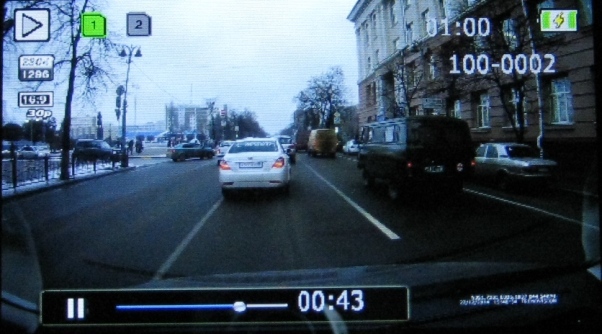
x3.4 increase
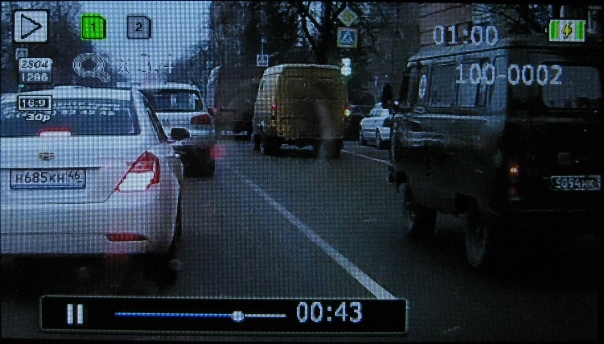
x4.6 increase

Freeze frame without zoom.
x3.4 increase
x4.6 increase
LDWS and FCWS mode.
Again, in many advertising reviews of a particular DVR model, the authors often focus on two modes: LDWS and FCWS. In TrendVision MR-710, these two modes are also implemented.
FCWS mode is a frontal collision warning system when approaching the car in front. Useful on highways.
LDWS mode is a lane change warning system. Useful on highways with road markings.
How these modes will be useful in real conditions, I can only guess. Making constant trips mostly only around the city, I personally do not use these modes. But making a long trip on the highway, these functions can really come in handy, especially if there is a tendency to fall asleep at the wheel.
Warning about changing lanes or a possible collision is carried out by the voice of a person. All voice prompts accompanying the operation of the DVR are also carried out in a human voice.
Below, under the spoiler is a brief information about TrendVision MR-710GP. Some technical features and software features in this section are described in more detail.
A brief description of the TrendVision MR-710GP dashcam
The DVR is built on the most up-to-date element base: the Ambarella A7LA70 processor, the OmniVision OV4689 matrix, an 8-lens lens F = 1.6 (!).
Optimal viewing angle: 147 ° diagonal, 107 ° horizontal.
Video resolution: SuperHD at 30 frames per second, FullHD at 60, 45 or 30 frames per second. You can set different resolution and exposure for day and night time of day (!).
The following recording modes are possible: WideHD 2560x1080, SuperHD 2304x1296, HighSpeedFLD 1920x1080 60P, FullHD 1920x1080 30P, HDR 1920x1080 30P and others.
You can correct the exposure and while driving with the help of two buttons. Step 0.3 ..0.4.
HDR (!), WDR implemented.
Turning on and off the DVR and recording is done automatically when applying and removing external power.
Video is recorded in time intervals of choice for 1, 2, 3, 5 minutes or without limitation. There are no gaps between files. When the memory card is full, the earliest video is automatically deleted and a new one is recorded instead.
The monitor is turned off during recording automatically after a user-defined time. The monitor is turned on during recording after pressing any button or when power is applied to the parking camera.
There is a built-in battery, which is enough for 20 minutes of battery life. To maintain the current time and date, another frost-resistant battery is provided. If a GPS receiver is used, the time and date will always be accurate, as they are synchronized with GPS data.
Thanks to GPS, the exact speed of movement will be displayed on the monitor, and when watching a video with the help of a special program, you can view the full driving route on a map.
It is possible to include a speed limit, above which the speed of movement will not be displayed and recorded. It is possible to overlay your license plate on the video.
In case of an accident, the video will automatically be protected from overwriting due to the G-sensor (shock sensor). There are 3 levels of sensitivity of the sensor. You can also protect any video from being overwritten while driving by pressing a button. For protected videos on the memory card, 20% of the space is allocated. When filling this space, the protected files will also begin to be overwritten by the new protected files.
If on-site accidents you decide to give the memory card with the record to the inspector DPS, then take care to make a copy of the video on the second memory card.
Motion sensor is.
You can watch any video with sound directly on the DVR itself. The overall situation will be clearly visible due to the large monitor. In order to see small details, such as a car number, a digital zoom is provided (!).
The work of the DVR is accompanied by voice prompts. There are voice alerts for LDWS and FCWS. The speaker volume is adjustable.
The new firmware will implement the SpeedCam (!) Function (notification of radar, cameras, traffic police posts).
The DVR is equipped with a polarizing CPL filter (!), Which eliminates reflections from the windshield. It is recommended to use in a sunny weather, it is not recommended to use at night.
Optimal viewing angle: 147 ° diagonal, 107 ° horizontal.
Video resolution: SuperHD at 30 frames per second, FullHD at 60, 45 or 30 frames per second. You can set different resolution and exposure for day and night time of day (!).
The following recording modes are possible: WideHD 2560x1080, SuperHD 2304x1296, HighSpeedFLD 1920x1080 60P, FullHD 1920x1080 30P, HDR 1920x1080 30P and others.
You can correct the exposure and while driving with the help of two buttons. Step 0.3 ..0.4.
HDR (!), WDR implemented.
Turning on and off the DVR and recording is done automatically when applying and removing external power.
Video is recorded in time intervals of choice for 1, 2, 3, 5 minutes or without limitation. There are no gaps between files. When the memory card is full, the earliest video is automatically deleted and a new one is recorded instead.
The monitor is turned off during recording automatically after a user-defined time. The monitor is turned on during recording after pressing any button or when power is applied to the parking camera.
There is a built-in battery, which is enough for 20 minutes of battery life. To maintain the current time and date, another frost-resistant battery is provided. If a GPS receiver is used, the time and date will always be accurate, as they are synchronized with GPS data.
Thanks to GPS, the exact speed of movement will be displayed on the monitor, and when watching a video with the help of a special program, you can view the full driving route on a map.
It is possible to include a speed limit, above which the speed of movement will not be displayed and recorded. It is possible to overlay your license plate on the video.
In case of an accident, the video will automatically be protected from overwriting due to the G-sensor (shock sensor). There are 3 levels of sensitivity of the sensor. You can also protect any video from being overwritten while driving by pressing a button. For protected videos on the memory card, 20% of the space is allocated. When filling this space, the protected files will also begin to be overwritten by the new protected files.
If on-site accidents you decide to give the memory card with the record to the inspector DPS, then take care to make a copy of the video on the second memory card.
Motion sensor is.
You can watch any video with sound directly on the DVR itself. The overall situation will be clearly visible due to the large monitor. In order to see small details, such as a car number, a digital zoom is provided (!).
The work of the DVR is accompanied by voice prompts. There are voice alerts for LDWS and FCWS. The speaker volume is adjustable.
The new firmware will implement the SpeedCam (!) Function (notification of radar, cameras, traffic police posts).
The DVR is equipped with a polarizing CPL filter (!), Which eliminates reflections from the windshield. It is recommended to use in a sunny weather, it is not recommended to use at night.
Examples of videos with TrendVision MR-710GP
Please note that YouTube video hosting significantly impairs video quality.
To assess the real quality of the video - download the original files!
SuperHD
Download original
SuperHD
Download original
HDR1080
Download original
HDR1080, night
Download original
HDR1080, night
Mini output
Definitely TrendVision MR-710GP is by far the best DVR in the mirror housing. With great confidence I can say that this model will retain its position throughout the whole of 2015.
If we compare this DVR-mirror with any other DVR in a different form factor, then without a doubt we can say that TrendVision MR-710GP is one of the leading lines among all DVRs in terms of technical characteristics, video quality, features and functionality. it is difficult to name the model that he would concede today.
Source: https://habr.com/ru/post/375259/
All Articles